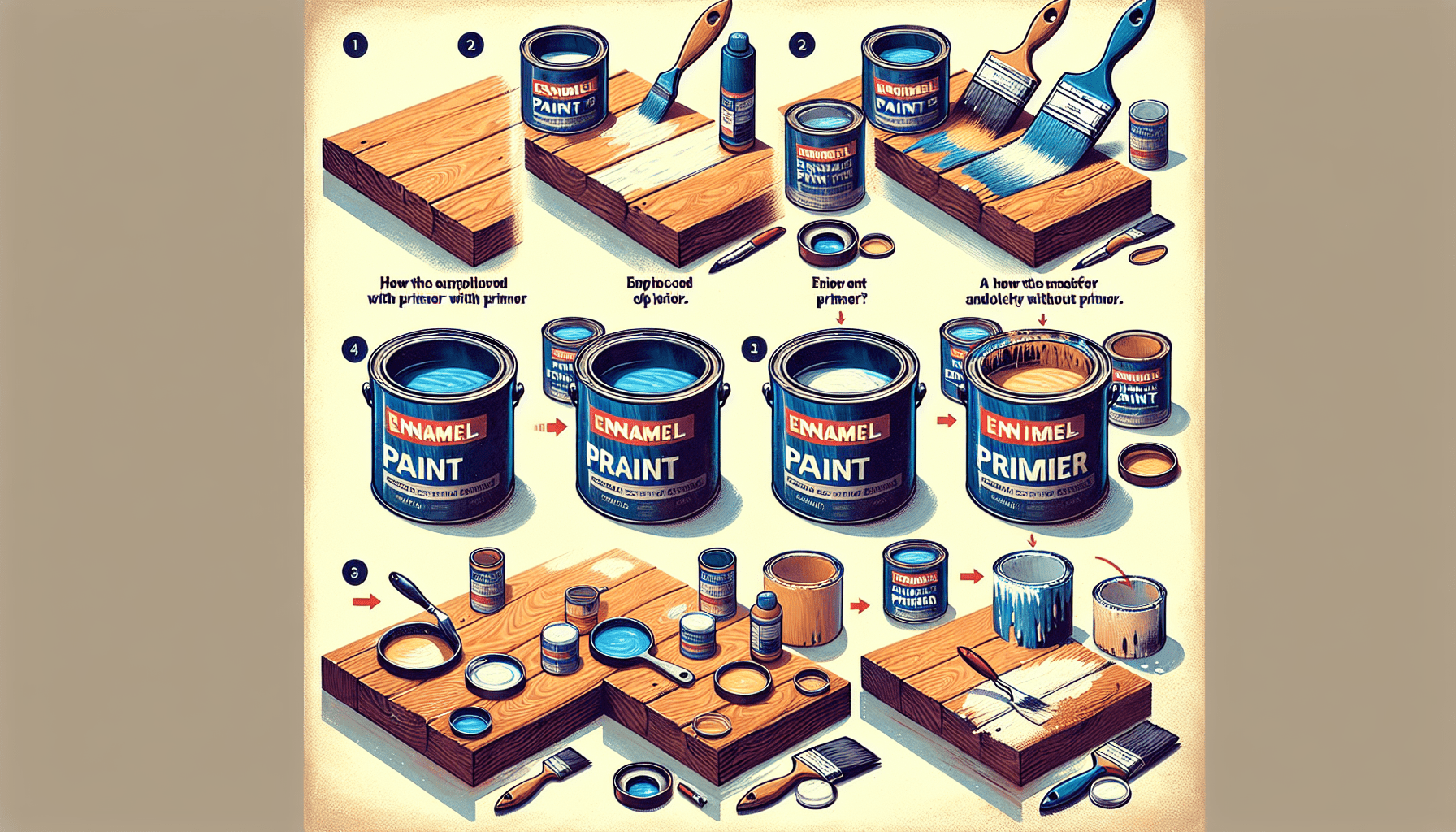In the world of home improvement, repainting a surface with enamel paint can be a daunting task, especially when it comes to painting over existing enamel without the need for sanding. However, fear not, as this article is here to provide you with a step-by-step guide on how to tackle this often challenging endeavor. By following these expert tips and techniques, you will be able to achieve a flawless, long-lasting paint finish that will transform any space without the tedious and time-consuming process of sanding. So, put away your sandpaper and get ready to unlock the secrets of painting over enamel paint without sanding.
Preparing the Surface
Before you begin painting over enamel, it is important to properly prepare the surface for the best results. There are a few steps involved in this process.
Gather the necessary materials
To prepare the surface, you will need a few key materials. These include a bucket of warm water, a mild detergent or cleaner, a sponge or soft cloth, a scraper or putty knife, some sandpaper, and masking tape or painter’s tape. Having these materials on hand will make the surface preparation process more efficient.
Clean the surface
The first step in preparing the surface is to clean it thoroughly. Use the warm water and mild detergent or cleaner to remove any dirt, grease, or grime that may be on the surface. Apply the cleaning solution using a sponge or soft cloth, and gently scrub the surface in a circular motion. Rinse the surface with clean water and allow it to dry completely before proceeding to the next steps.
Repair any damage
Inspect the surface for any damage that may need to be repaired before painting. This could include cracks, holes, or imperfections. Use a scraper or putty knife to fill in any cracks or holes with a suitable filler or putty. Smooth out the repaired areas with sandpaper, ensuring that they are level with the rest of the surface. Once the repairs are complete, clean off any dust or debris left behind.
Protect surrounding areas
Before you start painting, it is essential to protect the surrounding areas from any paint splatters or drips. Use masking tape or painter’s tape to cover areas such as trim, windows, or anything you don’t want to be painted. Additionally, lay down drop cloths or plastic sheets to protect the floor or furniture from any accidental spills or stains.
Priming the Enamel Paint
Once the surface is properly prepared, it is time to prime the enamel paint. Priming helps improve paint adhesion and provides a smooth base for the new paint.
Choose the right primer
Selecting the appropriate primer for your project is crucial. There are various primers available, such as those specifically designed for enamel surfaces. Look for a primer that is compatible with both enamel paint and the surface you are painting on. Consider factors such as the type of surface (e.g., wood, metal), the condition of the enamel paint, and any specific requirements mentioned on the primer’s label.
Apply the primer
Apply the primer evenly using a brush or roller. Start from one corner of the surface and work your way across, ensuring thorough coverage. Use smooth, even strokes, and make sure there are no visible brush or roller marks. Pay attention to any detailed or textured areas, ensuring that the primer reaches all the crevices. Allow the primer to dry completely according to the manufacturer’s instructions before moving on to the next steps.

Choosing the Paint
Selecting the right type of paint is a crucial step in achieving a successful painting project. Consider the paint type, finish, and compatibility with enamel paint.
Select a paint type
There are various types of paints available, such as latex, oil-based, or water-based paints. When painting over enamel, it is essential to choose a paint specifically designed for this purpose. Look for paints labeled as “enamel paint compatible” or “suitable for painting over enamel.” These paints are formulated to adhere effectively to enamel surfaces without the need for sanding.
Consider the finish
The choice of paint finish depends on your preferences and the intended use of the painted surface. Common paint finishes include matte, eggshell, satin, semi-gloss, and high-gloss. Consider factors such as durability, ease of maintenance, and desired appearance when selecting the paint finish. Some finishes may work better with enamel paint, so it is essential to check the paint label or consult with a professional if you are unsure.
Check compatibility with enamel paint
Before purchasing the paint, double-check that it is compatible with enamel paint. Some paints may not adhere well to enamel surfaces or may require additional priming or preparation steps. Ensure that the paint label specifies compatibility with enamel paint to avoid any unwanted results or paint failure.
Applying the Paint
Once the primer has dried, it is time to apply the paint. Proper application techniques are crucial to achieving a smooth and professional-looking finish.
Stir the paint well
Before applying the paint, give it a good stir to ensure an even consistency. Enamel paints tend to settle over time, and stirring will help recombine any separated pigment and solvents. Use a stir stick or paint mixer to thoroughly mix the paint, but be careful not to introduce air bubbles into the mixture.
Use a quality brush or roller
Selecting the right applicator is essential to achieve a flawless finish. For smaller areas or detailed work, use a high-quality brush specifically designed for the type of paint you are using. If you are painting larger surfaces, consider using a high-quality roller that is suitable for the paint type and finish. A brush or roller with the proper bristle or nap length will ensure even coverage and a smooth application.
Apply thin coats
When applying the paint, it is essential to remember that thin coats are better than thick ones. Thick coats of paint can lead to drips, uneven drying, and an unprofessional finish. Apply the paint using long, smooth strokes, starting from one corner and working your way across the surface. This technique will help minimize visible brush or roller marks and ensure an even distribution of paint.
Allow each coat to dry before applying the next
To achieve a professional-looking finish, allow each coat of paint to dry completely before applying the next one. The drying time can vary depending on the paint type and environmental conditions, so refer to the manufacturer’s instructions for specific drying times. Rushing the process may result in paint smudging, lifting, or poor adhesion.
Sand between coats if necessary
If the surface appears rough or you notice any imperfections after a coat of paint has dried, you may need to lightly sand the area before applying the next coat. Use fine-grit sandpaper and gently sand the surface in a circular motion. Once smooth, remove any sanding dust with a clean cloth or brush before proceeding with the next coat of paint. Sanding between coats can help create a smoother finish and improve adhesion.

Correcting Mistakes
Mistakes happen during painting projects, but they can be easily corrected with the right techniques.
Remove drips or runs
If you notice any drips or runs in the paint, act quickly to remove them. Use a clean cloth or sponge to carefully blot away the excess paint before it dries. Avoid smearing or spreading the paint further, as this can make the mistake more challenging to fix. Once the area is clean, touch up with a small brush to blend the surrounding paint and ensure a seamless appearance.
Fix uneven coverage
If you encounter areas with uneven coverage or thin spots, you may need to touch them up separately. Load a small brush with a small amount of paint and carefully apply it to the affected area. Blend the newly applied paint with the surrounding areas to create a consistent and even appearance. Take your time and use a steady hand to ensure a seamless result.
Touch up any missed spots
After the initial paint application, it is crucial to inspect the entire surface for any missed spots. Look for areas where the primer or enamel paint may still be visible or where the coverage is inadequate. Use a small brush or roller to touch up these areas, ensuring that they blend in seamlessly with the rest of the painted surface.
Sealing the Paint
Sealing the painted surface adds an extra layer of protection and enhances the longevity of the paint job. Consider the appropriate sealer and follow the application guidelines.
Choose an appropriate sealer
Select a sealer that is compatible with the type of paint you used and suitable for the specific surface. Look for sealers labeled as compatible with enamel paint to ensure compatibility. Some sealers may also provide additional benefits such as UV resistance, moisture protection, or increased durability. Choose a sealer that meets your specific needs and preferences.
Apply the sealer
Follow the manufacturer’s instructions for applying the sealer. Use a brush, roller, or sprayer depending on the sealer type and the size of the surface. Apply the sealer evenly, ensuring that it covers the entire painted area. Take care not to apply too much sealer, as it can lead to a glossy or uneven appearance. Allow the sealer to dry completely according to the manufacturer’s instructions before considering the project complete.
Caring for the Painted Surface
Proper care will help maintain the beauty and longevity of your painted surface.
Avoid harsh chemicals and abrasives
To protect the painted surface, avoid using harsh chemicals or abrasive cleaners. These substances can damage the paint finish and result in premature wear or discoloration. Instead, opt for mild soap and water when cleaning the painted surface. Gently wipe the surface with a soft cloth or sponge to remove any dirt or stains, being careful not to scrub vigorously.
Clean gently with mild soap and water
Regular cleaning is essential to keep the painted surface looking its best. Use a mild soap solution and warm water to clean the surface as needed. Dip a soft cloth or sponge into the solution and gently wipe the surface in a circular motion. Rinse with clean water and dry with a soft, lint-free cloth to prevent water spots or streaks.
Apply a protective coating, if desired
For added protection and longevity, consider applying a protective coating to the painted surface. There are various coatings available, such as clear topcoats or wax sealants, that can provide an extra layer of protection against wear, stains, or fading. Follow the manufacturer’s instructions for applying the protective coating and allow it to dry completely before using or exposing the surface to potential damage.
Additional Tips and Considerations
Here are some additional tips and considerations to keep in mind when painting over enamel without sanding:
Test the paint on a small inconspicuous area first
Before starting the entire painting project, it is essential to conduct a small test on an inconspicuous area. Apply the primer and paint as you would on the rest of the surface and evaluate the results. This test will help you determine if the paint adheres well to the enamel and if the desired finish is achieved. If the results are satisfactory, proceed with the rest of the project.
Consider using a bonding primer for better adhesion
If you are concerned about paint adhesion or are painting a challenging surface, consider using a bonding primer. A bonding primer is specifically designed to improve adhesion on smooth or glossy surfaces, such as enamel paint. It creates a strong bond between the surface and the paint, reducing the risk of paint failure or peeling.
Follow the manufacturer’s instructions for drying times
Drying times can vary depending on the type of paint, primer, and sealer being used. To ensure the best results, always follow the manufacturer’s instructions for drying times between coats, as well as overall curing times. Rushing the process or applying subsequent coats too soon can compromise the finish, adhesion, and durability of the paint.
Ventilate the area properly
When painting, ensure that the area is well-ventilated to promote proper drying and to prevent the buildup of fumes or odors. Open windows or use fans to circulate fresh air throughout the space. If necessary, wear a respiratory mask to protect yourself from any strong or unpleasant odors.
Wear appropriate safety gear
Safety should always be a priority when painting. Wear appropriate safety gear, such as gloves, goggles, and protective clothing, to protect yourself from potential hazards. This is especially important when working with primers, paints, or sealers that may contain chemicals or irritants. Follow the manufacturer’s safety guidelines and recommendations for the products you are using.
Conclusion
By following these steps and tips, you can successfully paint over enamel without the need for sanding. Properly preparing the surface, choosing the right primer and paint, applying them correctly, and addressing any mistakes or imperfections will help you achieve a professional-looking finish. Remember to care for the painted surface using gentle cleaning methods and consider applying a protective coating for added durability. With a well-executed paint job, you can enjoy your refreshed surface without the hassle and mess of sanding.



